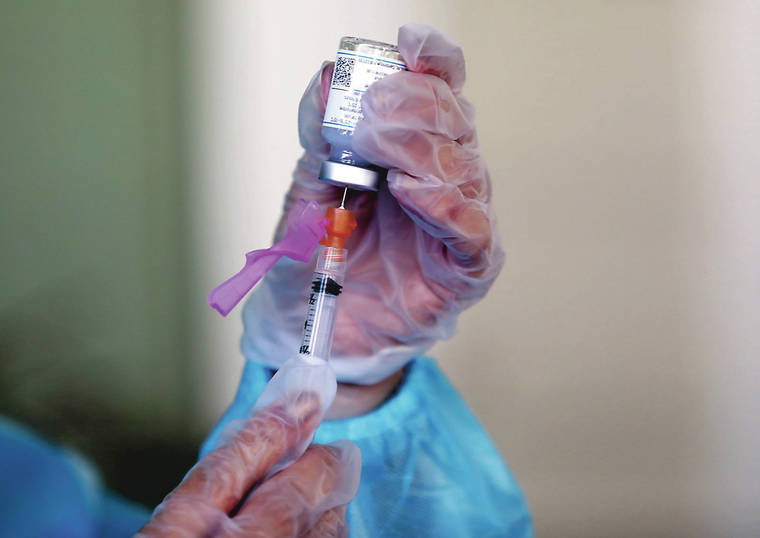As COVID-19 vaccinations ramp up statewide, Bay Clinic, Ka‘u Rural Health Community Association and Ka‘u Hospital and Rural Health Clinic are among those working to take vaccines to Big Island residents who might not be able to receive a shot otherwise.
“We recognize the need for rural areas to get the vaccine,” Bay Clinic CEO Kimo Alameda said.
Bay Clinic last month, with help from the health association, the rural health clinic and Hui Malama Ola Na ‘Oiwi, provided the first dose of vaccines to approximately 160 kupuna in Naalehu.
They returned this past Saturday to provide 160 second vaccine doses.
And this Saturday, Bay Clinic, supported by Hui Malama Ola Na ‘Oiwi, will bring 150 doses of the single-shot Johnson &Johnson vaccine to Milolii in West Hawaii.
Alameda said the original plan was to bus those residents into Naalehu or to the West Hawaii Community Health Center, but that effort would be a logistical challenge.
“That became Plan B and Plan A was how can we take the vaccine to them,” he said.
Efforts to provide vaccines in rural communities is part of the Bay Clinic’s mission, Alameda said.
“Federally Qualified Health Centers were established to serve the underserved and those without insurance,” he said. “And second, when we (evaluate) the health landscape and see what the other health entities are providing, we believe there’s a gap and that gap is bringing vaccines to the most at-need in the most geographically rural areas on the island.”
Dr. Jennifer Wai-Yan Kalani Shrestha, a primary care physician at Ka‘u Hospital and Rural Health Clinic, which is part of the East Hawaii Region of the Hawaii Health Systems Corp., said the rural health clinic was fortunate to collaborate with Bay Clinic.
“Together, we really rallied to get our kupuna vaccinated in Ka‘u,” she said. “… It was just a wonderful community effort.”
There are many factors at play when it comes to vaccine distribution across the state.
For the longest time, Shrestha said it was difficult for many to use the online vaccine registration system. Some residents don’t have fast internet access, and others don’t have email addresses — barriers that made it difficult for kupuna to get a vaccine.
And even if vaccines were scheduled, transportation and finances also can pose challenges to those seeking a dose, she said.
According to Shrestha, some also are wary of getting a new vaccine.
Trust in medicine “may be strained for people who have not been appropriately care for by the medical system.”
However, Jessie Marques, executive director of the Ka‘u Rural Health Community Association, said supply itself remains the biggest challenge.
Demand is greater than what is available for Ka‘u’s 6,000 to 8,000 residents.
President Joe Biden earlier this month directed that states make all adults eligible for the COVID-19 vaccine no later than May 1, but Marques said if the district can’t get vaccines for the current priority tiers, “how are we in the … neighbor island rural communities going to get access to vaccine for everyone?”
Supplies, she said, are controlled by the state Department of Health, “and nobody seems to know what the protocol is. What is the protocol for dissemination?”
“While working in Ka‘u, it has been heartbreaking to see how medical systems in more affluent areas of the island received their vaccines first. … It makes our community feel like we are forgotten, like we are second-class citizens, that our lives may not be as valued as other areas of the island,” said Shrestha.
“We are the largest district on the island with the highest population of Native Hawaiians and Marshallese — two of the most heavily affected ethnic groups during this pandemic. What happened to our vaccines?”
DOH spokesman Brooks Baeher said there are many challenges to the equitable distribution of vaccines, including language, technology and geography.
“The Department of Health is working to meet those challenges in the Ka‘u District and other remote communities around the state,” he said.
According to Baeher, the Hawaii District Health Office is working to build vaccination capacity in the district and is providing Moderna vaccines to the Ka‘u Rural Health Clinic and providing the Johnson &Johnson vaccines to Bay Clinic for its outreach efforts in Milolii.
The health office also is coordinating with the West Hawaii Community Health Center to provide vaccines in Ocean View, he said.
Additionally, Longs Drugs is scheduled to begin offering vaccinations at its Pahala location Sunday, March 21.
For her part, Denise Mackey, regional administrator for long-term care and critical access hospitals for the HHSC East Hawaii Region, said vaccine supply isn’t the largest challenge, but rather has “more to do with all the logistics of pulling it all together.”
A lot of resources are needed to roll out vaccinations, and it’s been difficult in all communities, she said.
Although barriers still exist, “we’re making progress, and that’s a good thing.”
Shrestha said the pandemic has heightened existing health disparities within Hawaii’s rural communities.
“I hope that addressing the vaccine disparities opens up more conversations about improving the health care infrastructure for our underserved, Pacific Islander communities in the future.”
Additional vaccination opportunities will be available soon in Ka‘u.
Bay Clinic will administer vaccines in Naalehu from 8:30 a.m.-4 p.m. two Fridays a month. The location will be an option in the federal vaccine administration management system, or VAMS.
The Ka‘u Rural Health Clinic will offer 40 shots per week, generally from 3-5 p.m. Tuesday-Friday. Shrestha said individuals 65 and older already have been scheduled for vaccinations this Tuesday through Thursday.
The inoculations will be done by appointment only. Those who want to become a patient of the clinic should drop by and complete a registration form, but patients cannot walk in and receive the vaccine on the same day.
Those who visit the clinic for the first dose of the vaccine must be able to come back to the clinic for their second dose.
Email Stephanie Salmons at ssalmons@hawaiitribune-herald.com.









